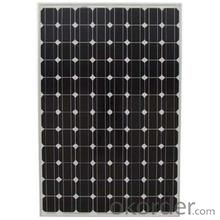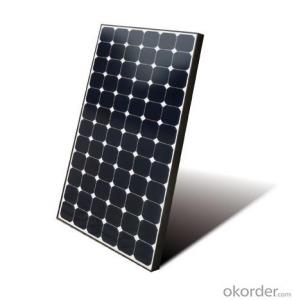CNBM On Grid System 2000W with Certificate UL TUV CE
- Loading Port:
- Shanghai
- Payment Terms:
- TT OR LC
- Min Order Qty:
- 100 watt
- Supply Capability:
- 1000 watt/month
OKorder Service Pledge
OKorder Financial Service
You Might Also Like
Item specifice
CNBM On Grid System 2000W with Certificate UL TUV CE
Product description
They range from small residential and commercial rooftop systems to large utility-scale solar power stations. Unlike stand-alone power systems, a grid-connected system rarely includes an integrated battery solution, as they are still very expensive. When conditions are right, the grid-connected PV system supplies the excess power, beyond consumption by the connected load, to the utility grid.
Connection of the photovoltaic power system can be done only through an interconnection agreement between the consumer and the utility company. The agreement details the various safety standards to be followed during the connection.[4]
Systems such as Net Metering and Feed-in Tariff which are offered by some system operators, can offset a customers electricity usage costs. In some locations though, grid technologies cannot cope with distributed generation feeding into the grid, so the export of surplus electricity is not possible and that surplus is earthed.
Grid-connected PV systems are comparatively easier to install as they do not require a battery system.[1][6]
Grid interconnection of photovoltaic (PV) power generation systems has the advantage of effective utilization of generated power because there are no storage losses involved.[7]
A photovoltaic power system is carbon negative over its lifespan, as any energy produced over and above that to build the panel initially offsets the need for burning fossil fuels. Even though the sun doesn't always shine, any installation gives a reasonably predictable average reduction in carbon consumption.

Application
Industrial
Commercial
Residential
Feature
Residential, grid-connected rooftop systems which have a capacity more than 10 kilowatts can meet the load of most consumers.[2] They can feed excess power to the grid where it is consumed by other users. The feedback is done through a meter to monitor power transferred. Photovoltaic wattage may be less than average consumption, in which case the consumer will continue to purchase grid energy, but a lesser amount than previously. If photovoltaic wattage substantially exceeds average consumption, the energy produced by the panels will be much in excess of the demand. In this case, the excess power can yield revenue by selling it to the grid. Depending on their agreement with their local grid energy company, the consumer only needs to pay the cost of electricity consumed less the value of electricity generated. This will be a negative number if more electricity is generated than consumed.[3] Additionally, in some cases, cash incentives are paid from the grid operator to the consumer.
Packaging
With carton and box
- Q:How do solar energy systems contribute to reducing carbon emissions?
- Solar energy systems play a crucial role in the reduction of carbon emissions through various means. Firstly, solar energy, being a renewable and eco-friendly power source, helps tackle this issue. By utilizing solar panels that convert sunlight into electricity without emitting any greenhouse gases, solar energy eliminates the release of carbon dioxide and other harmful pollutants into the atmosphere, a stark contrast to traditional fossil fuel power plants. Secondly, solar energy has the potential to replace the usage of fossil fuels in multiple sectors. For instance, residential rooftops can be fitted with solar panels to generate electricity for homes, reducing the dependence on coal or natural gas for power generation. Similarly, solar farms can be established to produce large-scale solar power for commercial and industrial purposes. By substituting fossil fuels, solar energy systems contribute to the reduction of carbon emissions associated with electricity generation. Furthermore, solar energy can also be utilized for heating purposes. Solar thermal systems can capture the sun's heat and provide hot water for residential and commercial buildings. By incorporating solar thermal systems, the demand for gas or electricity to heat water diminishes, resulting in a decrease in carbon emissions during the water heating process. Moreover, the widespread adoption of solar energy systems can lead to an overall decrease in the demand for fossil fuels. As more households, businesses, and industries transition to solar power, the need for coal, oil, and natural gas diminishes. Consequently, this reduced demand for fossil fuels can drive down their production and consumption, resulting in a significant reduction in carbon emissions associated with their extraction, refining, and combustion. In conclusion, solar energy systems contribute to the reduction of carbon emissions by producing clean and renewable electricity, replacing fossil fuels, reducing the demand for traditional energy sources, and providing an alternative for heating purposes. By embracing solar power, we can make substantial progress in combating climate change and strive towards a sustainable future.
- Q:What is the impact of electromagnetic interference on solar energy system performance?
- Electromagnetic interference can have a negative impact on the performance of solar energy systems. It can disrupt the communication and control signals within the system, leading to reduced efficiency and functionality. Additionally, electromagnetic interference can introduce noise and disturbances in the power output, affecting the overall reliability and stability of the system. Therefore, proper shielding and mitigation techniques need to be implemented to minimize the impact of electromagnetic interference on solar energy system performance.
- Q:What is the impact of air pollution on solar panel efficiency?
- Air pollution has a negative impact on solar panel efficiency as it reduces the amount of sunlight reaching the panels, thereby decreasing their energy generation capacity. Dust, smog, and other particles in the air create a layer on the surface of the panels, hindering the absorption of sunlight. Regular cleaning and maintenance are required to ensure optimal efficiency and performance of solar panels in areas with high air pollution.
- Q:Are there any environmental impacts associated with solar energy systems?
- Solar energy systems do have some environmental impacts, although they are generally considered to be much less harmful than those associated with traditional energy sources. Greenhouse gases and other pollutants can be released during the production and disposal of solar panels, especially if not managed properly. Additionally, the mining and extraction of raw materials used in solar panels, like silicon, can cause negative environmental consequences. However, these impacts are relatively minor when compared to the emissions and pollution caused by fossil fuel-based energy generation. Moreover, solar energy systems do not generate air or water pollution during operation and do not contribute to climate change. Overall, while there are some environmental impacts related to solar energy systems, they are significantly outweighed by the long-term benefits of reducing greenhouse gas emissions and transitioning to clean and renewable energy sources.
- Q:Can solar energy systems be used for powering off-grid research facilities?
- Yes, solar energy systems can be used very effectively for powering off-grid research facilities. Solar panels can generate electricity from sunlight, which can then be stored in batteries for use during times when the sun is not shining. This allows research facilities located in remote or off-grid areas to have a reliable and sustainable source of power, reducing or eliminating the need for traditional grid-based electricity. Additionally, solar energy systems are environmentally friendly and have minimal maintenance requirements, making them a viable and cost-effective solution for off-grid research facilities.
- Q:Can solar energy systems be used in areas with limited access to solar energy net metering programs?
- Yes, solar energy systems can still be used in areas with limited access to solar energy net metering programs. While net metering programs allow solar energy system owners to receive credits for excess energy they produce, the absence of such programs does not render solar energy systems useless. These systems can still generate and utilize renewable energy for on-site consumption, reducing reliance on traditional energy sources and potentially lowering electricity bills. Additionally, in some cases, solar energy systems can be designed to incorporate battery storage technologies, allowing for the storage of excess energy for use during periods of limited sunlight or higher demand.
- Q:Can solar energy systems be used in areas with high levels of bird activity?
- Yes, solar energy systems can be used in areas with high levels of bird activity. However, it is important to take certain precautions to ensure the safety of the birds and the optimal functioning of the solar panels. One common concern is the potential for bird collisions with the panels. To mitigate this, manufacturers often incorporate bird deterrents such as mesh screens or reflective coatings on the panels to make them more visible to birds and reduce the risk of collisions. Additionally, proper installation and maintenance of the solar energy systems can help minimize potential nesting or roosting sites for birds, reducing the likelihood of damage to the panels. By addressing these considerations, solar energy systems can be effectively utilized in areas with high bird activity while still protecting the local avian population.
- Q:Can a solar energy system be installed on a school or university campus?
- Yes, a solar energy system can be installed on a school or university campus. In fact, many educational institutions have already embraced solar power as a sustainable and cost-effective energy solution. Installing solar panels on rooftops or in open spaces can generate clean electricity that can be used to power buildings, reduce dependence on the grid, and contribute to a greener campus. Additionally, these systems can serve as educational tools, allowing students to learn about renewable energy and environmental sustainability firsthand.
- Q:How do solar energy systems perform in different weather conditions?
- Solar energy systems can still produce electricity even in cloudy or rainy weather, although their performance may be reduced compared to sunny conditions. However, extreme weather conditions like heavy snow or hail can potentially impact the efficiency of solar panels. Overall, solar energy systems are designed to withstand various weather conditions and can still generate power to some extent, but their output may vary depending on the weather.
- Q:Are solar energy systems suitable for agricultural applications?
- Yes, solar energy systems are highly suitable for agricultural applications. They provide a clean and renewable source of power that can be used to meet the energy needs of various agricultural activities such as irrigation, crop drying, and powering electric fences. Solar energy systems are cost-effective, environmentally friendly, and can be easily installed in rural areas, making them an ideal choice for farmers and agricultural businesses.
1. Manufacturer Overview |
|
|---|---|
| Location | |
| Year Established | |
| Annual Output Value | |
| Main Markets | |
| Company Certifications | |
2. Manufacturer Certificates |
|
|---|---|
| a) Certification Name | |
| Range | |
| Reference | |
| Validity Period | |
3. Manufacturer Capability |
|
|---|---|
| a)Trade Capacity | |
| Nearest Port | |
| Export Percentage | |
| No.of Employees in Trade Department | |
| Language Spoken: | |
| b)Factory Information | |
| Factory Size: | |
| No. of Production Lines | |
| Contract Manufacturing | |
| Product Price Range | |
Send your message to us
CNBM On Grid System 2000W with Certificate UL TUV CE
- Loading Port:
- Shanghai
- Payment Terms:
- TT OR LC
- Min Order Qty:
- 100 watt
- Supply Capability:
- 1000 watt/month
OKorder Service Pledge
OKorder Financial Service
Similar products
New products
Hot products
Related keywords





























